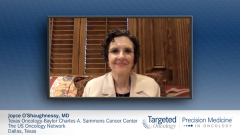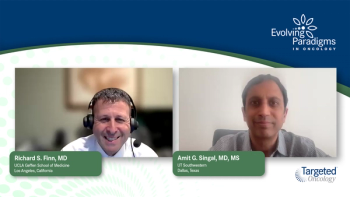
PROTECTIVE Trials of Plinabulin in Solid Tumors
An overview of the Protective-1 trial of single-agent plinabulin vs pegfilgrastim after docetaxel in patients with advanced breast cancer, advanced non–small cell lung cancer, and hormone-refractory prostate cancer.
Episodes in this series

Joyce O’Shaughnessy, MD: You have activation of T cells, which in the context of tumors blowing apart with chemotherapy is helpful to have activated dendritic cells and T cells. That’s 1 immunomodulatory connection that I understand. Of course, I immediately think, “That’s going to come in handy now that we’re going to use checkpoint inhibitors in the context of our patients with triple-negative breast cancer, where we need all the immuno-stimulatory things we can get.” Also, the plinabulin can have a direct antitumor effect because it’s a microtubule-disrupting agent. It’s like adding another set of toxic agents in there. Without toxicity it’s like a freebie. I was reading that it also can stop and kill proliferating endothelial cells that are trying to angiogenesis, etc. But the thing that’s going to lead to its initial clinical utility is this ability to protect the bone marrow, which is fascinating because somehow in disrupting polymerization within the hematopoietic progenitor stem cell compartment, you must be freezing these things. You protect them. They’re protected during that initial day or 2 where there are high levels of cytotoxic agent. I don’t pretend to understand how to connect every dot there on that 1, Andy, but that’s the case. It’s protecting.
Andrew D. Seidman, MD: If I was going to do a clinical trial with this drug, I would call it the protective trial.
Joyce O’Shaughnessy, MD: There you go.
Andrew D. Seidman, MD: And there is such a study.
Joyce O’Shaughnessy, MD: You’re right. That was a good name. I hadn’t appreciated what a good name it was, but it’s a really good name. It’s protective: it’s protecting the hematopoietic stem cell compartment. And it leads to these cells being there when the coast is clear, and the cytotoxic agents are gone. They haven’t been killed off at the cytotoxic agent. Then they can work to protect the patient during the first week of the chemotherapy where we have our gap. It’s multimechanism, a pleiotropic mechanism of action—very easy to give, right? It’s 30 minutes IV [intravenous], and it’s given in the same session as the chemotherapy. From what I’ve seen, and the trials that they’ve done are quite numerous—it’s actually nontoxic. I remember not being able to ascertain any additional toxicity from the agent.
Andrew D. Seidman, MD: Yes. You think about colchicine, which is used primarily for gout, right? Colchicine can cause some diarrhea, but I’m just trying to think of an analog of a microtubule agent that certainly isn’t a cytotoxic agent. In the data that Doug Blayney presented at ASCO [American Society of Clinical Oncology Annual Meeting] 2021, the Protective-1 trial randomized 105 patients with breast, prostate, or lung cancer who would appropriately get docetaxel at 75 mg/m2 every 3 weeks. They got 4 cycles. The comparison was pegfilgrastim vs plinabulin with a placebo control in each arm. How do these 2 compare? With a primary end point showing that plinabulin wouldn’t be inferior to single agent pegfilgrastim for duration of severe neutropenia, as we discussed before that severe neutropenia is so important [to avoid]. It wasn’t inferior to pegfilgrastim in terms of having that period of severe neutropenia. So, it’s not a myeloid growth factor in the sense of GCSF, but it offered that same level of protection.
Joyce O’Shaughnessy, MD: Absolutely remarkable.
Andrew D. Seidman, MD: I don’t have all this at the top of my head, so I’m just going to cite some other exploratory objectives. Febrile neutropenia didn’t occur in the 52 patients who got plinabulin. There were a few cases. Two percent got febrile neutropenia, who got pegfilgrastim. Numerically, there was less infection and there was less docetaxel dose discontinuation and dose delay. These weren’t statistically significant but numerically trended in favor of plinabulin compared with pegfilgrastim. Then pegfilgrastim was numerically superior in terms of antibiotic use and hospitalization by 2% in each of those 2 categories—not statistically significant, but we also were talking about bone pain before and platelets. There was also a statistically significant reduction in favoring plinabulin over pegfilgrastim in terms of bone pain with a P value of .01, and in terms of thrombocytopenia with a P value of .0001. Going head-to-head against pegfilgrastim isn’t an easy thing.
Joyce O’Shaughnessy, MD: Remarkable. This is a stunning trial to me. First, it’s a courageous trial to go head-to-head because the other trial we’ll talk about added plinabulin to the pegfilgrastim in the context of a super myelosuppressive regimen or TAC [docetaxel, doxorubicin hydrochloride, cyclophosphamide] regimen. But this was more in the 10%-to-20% double-neutropenia range. This is the more moderately myelosuppressive, the docetaxel 75 mg/m every 3 weeks. The thing about pegfilgrastim is that it stays around for a while. We think, “We’re going to protect the matter. We’re going to build it up. We’re going to have an agent that’s PEGylated and it’s going to stay around until the neutrophils recover. Then the neutrophils clear it out. It’s there the whole time. This is different. This is not a myeloproliferative agent at all. It doesn’t build up your neutrophils; it protects your neutrophils. You’re getting it just once every 3 weeks for 30 minutes IV. It’s mind-blowing because it’s protective. You don’t have anything to build back up again because it goes up and down in the first place.
But to go head-to-head against such an incredible agent as pegfilgrastim, then to meet the primary end point of noninferiority—noninferiority in terms of duration of severe neutropenia is mind-blowing to me, honestly, because we’re used to the importance of pegfilgrastim—and here comes an agent. Now, this is a small trial. It was only 50-something patients per arm. As you said, these numbers met its primary end point for noninferiority, but all the other things you mentioned, of course, were just more exploratory. Still, it’s noninferior and had comparison. I don’t know, Andy, whether we’ll end up using it. Maybe we will in these kinds of regimens where you’d like an extra protection for the patient, but you don’t want to overly stimulate it. I wouldn’t use pegfilgrastim with 75 mg/m of docetaxel. I’d get down to 60 mg/m. If I was worried about somebody’s liver or something, I’d get down to 60 mg/m. I wouldn’t use that. I’d be afraid I’d overshoot the mark and burn marrow, and I wouldn’t use it there. However, there are certain patients for whom I’d like to have an extra level of protection. I could see using single agent plinabulin for those patients, for our patients who have a myelosuppressive therapy.
Transcript edited for clarity.








































